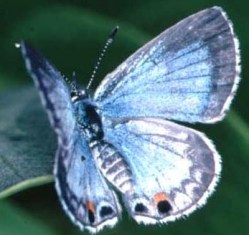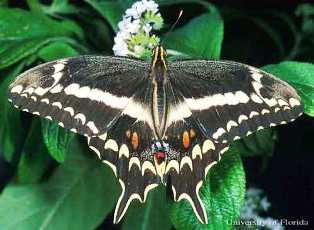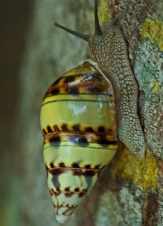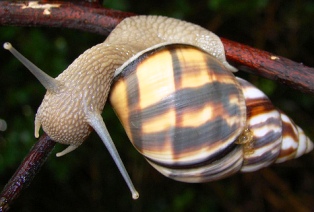Discover Florida Nature
It's time to explore the natural Florida


|
|
|
|
|
|
Invertebrates have four species endangered in the state
of Florida. They have no threatened species at this time, but have four
species of special concern.. Of the million or more animal species in
the world, more than 98% are invertebrates. Invertebrates don't have an
internal skeleton made of bone. Many invertebrates have a fluid-filled,
hydrostatic skeleton, like the jelly fish or worm. Others have a hard
outer shell, like insects and crustaceans. There are many types of
invertebrates. The most common invertebrates include the protozoa,
annelids, echinoderms, mollusks and arthropods. Arthropods include
insects, crustaceans and arachnids. Endangered and at risk invertebrates
in the state of Florida include
corals, crustaceans,
insects, and mollusks.
Insects- There are well over 1 million different known species of insects in the world, and some experts estimate that there might be as many as 10 million. Insects are arthropods (an invertebrate that has an external skeleton, a segmented body, and jointed attachments called appendages).Insects have a hard external skeleton, a three-part body, three pairs of jointed legs, compound eyes, and two antennae. They are the most diverse group of animals on the planet. Insects represent more than half of all known living organisms!  Miami
Blue Butterfly (Cyclargus)
Endangered- The Miami blue
butterfly is a small, brightly colored butterfly endemic to Florida.
Males are bright metallic blue dorsally. Females are primarily dark gray
with blue scaling toward the wing bases and orange-capped black
sub-marginal eyespots on each hind wing. The Miami blue butterfly was
thought to be extinct after the only remaining colony, which was located
on Key Biscayne, was wiped out by Hurricane Andrew in 1992. Once
abundant and widespread, the butterfly has become considerably more rare
and now only occurs in a single small, isolated colony site within the
boundaries of Bahia Honda State Park in the Lower Florida Keys. An
interesting aspect of the Miami blue's life cycle is that its
caterpillars are sometimes tended by ants much like ants tend aphids. Miami
Blue Butterfly (Cyclargus)
Endangered- The Miami blue
butterfly is a small, brightly colored butterfly endemic to Florida.
Males are bright metallic blue dorsally. Females are primarily dark gray
with blue scaling toward the wing bases and orange-capped black
sub-marginal eyespots on each hind wing. The Miami blue butterfly was
thought to be extinct after the only remaining colony, which was located
on Key Biscayne, was wiped out by Hurricane Andrew in 1992. Once
abundant and widespread, the butterfly has become considerably more rare
and now only occurs in a single small, isolated colony site within the
boundaries of Bahia Honda State Park in the Lower Florida Keys. An
interesting aspect of the Miami blue's life cycle is that its
caterpillars are sometimes tended by ants much like ants tend aphids. Schaus’
Swallowtail Butterfly (Heraclides aristodemus ponceanus)
Endangered- Named after Dr.
William Schaus who discovered the large, showy butterfly in Miami at the
turn of the last century, the Schaus swallowtail was one of the first
insects protected under the Endangered Species Act. It is also one of
the rarest on the list. The butterfly depends upon the semi-shade of
tropical hardwood forests (hammocks) to survive. Its original territory
in South Florida has shrunken considerably; now it is only found in the
Florida Keys. Dark brown and yellow butterfly with a wingspan of about 4
inches and "tails" that are straight-edged rather than teardrop shaped. Schaus’
Swallowtail Butterfly (Heraclides aristodemus ponceanus)
Endangered- Named after Dr.
William Schaus who discovered the large, showy butterfly in Miami at the
turn of the last century, the Schaus swallowtail was one of the first
insects protected under the Endangered Species Act. It is also one of
the rarest on the list. The butterfly depends upon the semi-shade of
tropical hardwood forests (hammocks) to survive. Its original territory
in South Florida has shrunken considerably; now it is only found in the
Florida Keys. Dark brown and yellow butterfly with a wingspan of about 4
inches and "tails" that are straight-edged rather than teardrop shaped. Mollusks- A mollusk is another name for a shellfish. Shellfish are not all fish and many of them live on land. Not all shellfish have shells! There are three groupings of shellfish. They include: Hatchet-footed - These live inside of two shells that are connected by a muscular hinge which can open and close the shell. They are referred to as bivalves. Lines on the shell tell how old the mollusk is as the shell gets bigger, the older the shellfish gets. Clams, scallops, oysters and mussels are bivalves. Belly-footed - These have just one spiral shell and carry their shells on their backs. They are called univalves. The snail, slug, periwinkle and conch belong to this group. Head-footed - These have a definite head surrounded by tentacles. The squid and octopus are two in this group.  Florida
Tree Snail (Liguus fasciatus)
SSC (1)- A large snail, the
Florida tree snail reaches a length of 1.6 - 2.7 inches. This snail has
a high conical shell of variable thickness and texture, with a white or
cream background color. Although sometimes solid white, the shell is
more often marked with streaks or bands of variable color (yellow,
brown, pink, green) and width. The Florida tree snail occurs from
Broward and Collier counties south through the Keys. The Snail body is
grayish tan without markings. This species prefers smooth-barked trees.
On the mainland it utilizes wild tamarind, poisonwood, gumbo limbo, and
mastic. Additional host trees in the Keys are Jamaican dogwood, pigeon
plum, ironwood, and other hardwoods native to the Florida Keys
hammocks. The Florida tree snail is dormant from December to April. Florida
Tree Snail (Liguus fasciatus)
SSC (1)- A large snail, the
Florida tree snail reaches a length of 1.6 - 2.7 inches. This snail has
a high conical shell of variable thickness and texture, with a white or
cream background color. Although sometimes solid white, the shell is
more often marked with streaks or bands of variable color (yellow,
brown, pink, green) and width. The Florida tree snail occurs from
Broward and Collier counties south through the Keys. The Snail body is
grayish tan without markings. This species prefers smooth-barked trees.
On the mainland it utilizes wild tamarind, poisonwood, gumbo limbo, and
mastic. Additional host trees in the Keys are Jamaican dogwood, pigeon
plum, ironwood, and other hardwoods native to the Florida Keys
hammocks. The Florida tree snail is dormant from December to April. Stock
Island Tree Snail (Orthalicus reses)
Endangered- The Stock Island
tree snail is an arboreal snail inhabiting the hardwood hammocks of the
Florida Keys. The Stock Island tree snail is a large, conical snail
attaining approximately 1 1/2- 2 inches length. The external ground
color is white to buff, with three poorly developed spiral bands and
several flame-like purple-brown axial stripes that stop at the lower of
the spiral bands. Historically, the Stock Island tree snail was believed
to have a very limited distribution, being found only in tropical
hardwood hammocks on Stock Island and Key West; although it may have
been found in other hammock areas in the Lower Keys. Their distribution
has since been artificially extended by collectors who have introduced
them to Key Largo and the southernmost parts of the mainland. Stock
Island Tree Snail (Orthalicus reses)
Endangered- The Stock Island
tree snail is an arboreal snail inhabiting the hardwood hammocks of the
Florida Keys. The Stock Island tree snail is a large, conical snail
attaining approximately 1 1/2- 2 inches length. The external ground
color is white to buff, with three poorly developed spiral bands and
several flame-like purple-brown axial stripes that stop at the lower of
the spiral bands. Historically, the Stock Island tree snail was believed
to have a very limited distribution, being found only in tropical
hardwood hammocks on Stock Island and Key West; although it may have
been found in other hammock areas in the Lower Keys. Their distribution
has since been artificially extended by collectors who have introduced
them to Key Largo and the southernmost parts of the mainland. |
|
|
Advertise | Privacy Statement | Dog Encyclopedia | Video |Contact | Alaska Nature |
|